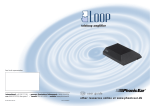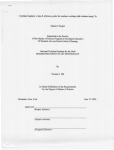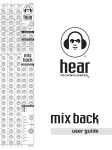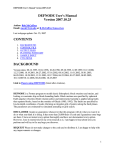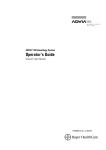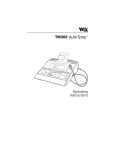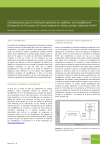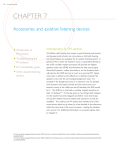Download A Sound Foundation Through Early Amplification 1998
Transcript
C HAPTER E IGHT One Size Does Not Fit All: Rationale and Procedures for FM System Fitting Dawna E. Lewis and Leisha R. Eiten Introduction Welcome to “Adventures in Audiology.” This week’s installment is entitled “The Nightmare Classroom.” As we begin our adventure, we find ourselves in Mr. Goodteacher’s second grade class. A glance around the room reveals 20 students seated at desks, arranged in groups of four and angled toward the front of the room. Two hard walls are covered with student artwork, while a chalkboard covers the third. It is an early fall day when the temperatures in this part of the country are still quite warm. Since this school does not have airconditioning, the windows, which cover the fourth wall, are open, and portable fans are running to keep the temperatures at a reasonable level. Outside, we hear the sounds of lawnmowers from neighboring yards and a city crew working on road repairs in front of the school. Today, Mr. Goodteacher is using one of the school’s overhead projectors as he introduces new math facts to the class. We can hear the projector’s fan as soon the equipment is turned on. In addition, we hear a constant humming, which we soon realize comes from the fluorescent lights overhead. As Mr. Goodteacher surveys the classroom he sees the usual levels of activity as students wiggle in their seats, open desk tops, tap pencils, and crinkle papers. In addition, he notes several students who do not seem to be following the lesson. One of those students is Mary, who is drawing pictures rather than looking at the teacher. Mary, who has a moderate hearing loss and wears binaural hearing instruments, has been placed near the front of the class for “preferential seating.” In addition, she was placed with her back to the window so that outside light would not make it difficult for her to see the teacher’s face. Today, that seating arrangement places her next to the overhead projector and near the open windows. Another student, Tommy, sits in the second row of the group of students and toward the back of the class. Sometimes Tommy, who has unresolved chronic otitis media, appears to function well in the classroom. Today is not one of those days, and Tommy is making a paper airplane out of his math paper. Finally, there is Bobby. He has a mild-to-moderate hearing loss and functions well with hearing instruments. However, today, like most days, he did not bring those instruments to school. Thus, despite “preferential seating,” Bobby rarely seems to know what is going on in class and has significant difficulty with most new material. In addition, he is often tired and restless by the afternoon. All of the other students, who have normal hearing, are attentive and following instructions (except Jenny, who has been sent to the principal’s office). Mr. Goodteacher is concerned about the three students who have hearing difficulties, and during lunch, he talks with Ms. N’Charge, the school principal. Together they decide that something must be done soon, before the school year progresses and the students fall too far behind. But what can they do? Can this classroom be saved? Tune in next time as we meet Audie Graham, pediatric audiologist, in our next installment “From Here to Audibility.” Establishing Candidacy for Classroom Amplification Research has shown that children with bilateral sensorineural hearing loss experience difficulties understanding speech in degraded listening environments (Finitzo-Hieber 1981; Finitzo-Hieber and Tillman 1978; Gengel 1971; Nabelek 1980; Olsen 1988; Ross and Giolas 1971). More recently, individuals with conductive minimal and unilateral hearing loss also havebeen shown to experience difficulties (Bess, Tharpe, and Gibler 1986; Boney and Bess 1974; Crandell 1993). There are groups of children with normal hearing who also have been 87 88 6 A Sound Foundation Through Early Amplification reported to experience difficulties understanding speech in the presence of distance, noise, and/or reverberation. These groups include young children (Allen and Wightman 1994; Crandell and Bess 1987; Elliott 1979; Finitzo-Hieber and Tillman 1978; Nabelek and Robinson 1982; Neuman and Hochberg 1983; Nozza et al. 1990), children with articulation or language problems (Crandell, McQuain, and Bess 1987; Elliott 1982), children diagnosed with learning disabilities or central auditory processing disorders (Flexer, Millin, and Brown 1990), non-native English speakers (Crandell and Smaldino 1996), and children with a history of conductive hearing loss (Gravel and Wallace 1992; Rosenfeld, Madell, and McMahon 1996). Classroom Acoustics One strategy to improve the listening conditions in classrooms is through the use of modifications to reduce extraneous noise from all sources (outside the school, inside the school but outside the classroom, and within the classroom). Examples include barriers to isolate the school from traffic noise, locating high noise areas of the school (e.g., cafeterias or music rooms) away from regular classrooms, and the use of absorptive materials within classrooms. For further information on classroom acoustics and acoustic modifications, the reader is referred to a number of excellent resources (Berg 1987, 1993, 1997; Crandell and Smaldino 1995; Gegg Rosenberg 1995). Another strategy to improve listening conditions in classrooms and other learning environments is through the use of amplification systems. This latter strategy is the focus of this chapter. Amplification Options for the Classroom Hearing Instruments The most common assistive devices considered for individuals with hearing loss are personal hearing instruments. As an amplification option for the classroom, hearing instruments have a number of benefits. First, using the student’s hearing instruments at school ensures that he or she will be using the same signal processing throughout the day. Hearing instrument choices have increased considerably in recent years, yielding a variety of style and processing schemes. When used appropriately, hearing instruments allow the student to hear the teacher, the voices of other students, and his or her own voice (although not to the same degree). They also are portable and do not require the student or teacher to wear additional equipment. However, practical issues must be addressed when using new hearing instrument technology as classroom amplification. These practical issues are summarized in table 1. In addition, there are many situations in which the ability of hearing instruments to process speech will be adversely affected by distance, noise, and reverberation. Using Rapid Speech Transmission Index (RASTI) measurements, Leavitt and Flexer (1991) examined the reproducibility of a speechlike signal at various distances from a sound source in a classroom. A score of 1.0 represents a perfect reproduction of the signal. Leavitt and Flexer (1991) reported scores of 0.83 at 2.65 meters from the source (front row, center seat) and 0.55 at 10.88 meters (back row, center seat). In fact, a score of 1.0 was obtained only at the reference location (6 inches from loudspeaker). Although these results cannot be compared directly to speech perception scores, they suggest that the signal reaching a hearing instrument microphone in the classroom will be degraded, often by a significant amount. Even if a hearing instrument were able to reproduce signals at the microphone perfectly, the student would hear a perfectly reproduced imperfect signal. Remote Microphone Table 1. Practical issues related to new hearing instrument technology as classroom amplification. Wide Dynamic Range Compression • Increased potential for feedback • Circuit noise in regions of normal hearing • Output tied to volume control • Limited power for individuals with severe-toprofound hearing loss • Limited to ability to amplify speech from a distance Multiple Memories • Remote control ◊ Who is in charge? ◊ Who monitors? • Selecting appropriate memories for classroom use Multiple Microphones • Remote control • Appropriate use in and out of the classroom ◊ Understanding communication rules ◊ Lecture ◊ Class discussion • Decreased localization ability when in directional microphone mode Rationale and Procedures for FM System Fitting 6 89 Table 2. Benefits and limitations of individual FM systems. Benefits • • • • Flexible for wide range of hearing losses May not require hearing instruments to operate Portable Can be used in multiple rooms in the same building Limitations • FM interference • Some systems require functioning hearing instruments with appropriate coupling • User must wear receiver • Troubleshooting/maintenance may be more complicated than with some other amplification devices Individual FM Systems Figure 1. Coupling options for use with FM systems. (From Lewis 1998.) Reprinted with permission. ©1998. Children with hearing impairment: Contemporary trends [pp. 277-295].Vanderbilt Bill Wilkerson Center Press. One of the best ways to reduce the effects of distance, noise, and reverberation is to place a remote microphone near the sound source (usually the talker’s mouth). Many classroom amplification systems employ a remote microphone to improve the signal-to-noise ratio (SNR) advantage for listeners with hearing loss. These include infrared systems, large area induction loop systems, sound field amplification systems, and individual frequency modulated (FM) systems. It is beyond the scope of this chapter to discuss all classroom amplification alternatives. Therefore, the focus will be on individual FM systems. For further information on other classroom amplification choices, the reader is referred to other sources (Berg 1993; Boothroyd 1981; Crandell, Smaldino, and Flexer 1995; DeConde Johnson et al. 1997; Gilmore 1995; Lewis 1994a, 1997). Figure 2. Lavalier-style FM microphone/transmitter (photo courtesy of AVR Sonovation). In individual FM systems the talker wears a microphone/transmitter from which signals are sent, via FM radio waves, to a receiver worn by the listener (figure 1). As a classroom amplification option, individual FM systems have benefits and limitations listed in table 2. Microphone/Transmitter Options. There are a variety of microphone/transmitter options available for use with FM systems. Lavalier microphones (figure 2) house the microphone and transmitter in a single case that is worn on the chest, approximately 6 to 8 inches from the talker’s mouth. An antenna usually hangs down from the bottom of the transmitter case. Lapel microphones (figure 3) are separate from the transmitter. The transmitter usually is worn at the waist or in a pocket. A microphone is plugged into the transmitter, clipped to the talker’s lapel, and the cord of the lapel microphone serves as the antenna. Other microphones that can plug into a separate Figure 3. Lapel-style FM microphone (photo courtesy of Phonak, Inc.). 90 6 A Sound Foundation Through Early Amplification Figure 4. Headworn-style FM microphone (photo courtesy of transmitter include headworn microphones (figure 4), which are worn over the top of the head or over the ears, and collar microphones (figure 5), which are worn around the neck. In these last two selections, the microphone is located much closer to the talker’s mouth, usually within 1 to 2 inches. Another option, less commonly used in classrooms, is the conference microphone (figure 6). This microphone is designed for use in situations where there will be multiple talkers in a relatively contained area (e.g., around a table, in a small group discussion). In most models, the transmitter plugs into a microphone base that is placed on the table. Sound is directed to the microphone from around the table. More recently, small conference microphones have been introduced that can easily be carried by the user. Several manufacturers have introduced small, handheld microphones (figure 7) for use with FM systems. Figure 5. Collar-style FM microphone (photo courtesy of Audio Enhancement). Figure 6. Conference-style FM microphones (photo courtesy of Audio Enhancement). These microphones are designed to be used by the individual wearing the FM receiver. Instead of the talker wearing the transmitter, the listener holds the transmitter and points it toward the talker. Adjustable directional/omnidirectional microphones allow the user to “focus in” on a talker in the presence of background noise. Each of the microphones has its own benefits and limitations, and these are summarized in table 3. In addition, the microphone features that are selected may affect the microphone’s use and performance. For example, many of the microphones may be either directional or omnidirectional. Directional microphones have openings around the sides and are less sensitive to sounds coming into the side openings than into the top of the microphone. When worn correctly, they can be helpful in noisy Figure 7. Hand-held FM microphone (photo courtesy of Phonak, Inc.). Rationale and Procedures for FM System Fitting 6 91 Table 3. Benefits and limitations of FM system microphone options. Reprinted by permission of Phonak AG. Microphone Style Features Advantages Disadvantages Lavalier • Microphone and transmitter in one case • Antenna extends from case • Microphone usually directional • Worn around the neck • Single case may simplify use • No need for waistband or belt to attach to transmitter • Weight of device around the neck may be uncomfortable • Single case for all components may complicate troubleshooting • Poor placement or head movement may degrade signal Lapel • Microphone and transmitter separate • Antenna in cord of lapel microphone • Microphone clips to lapel or may hang around neck • Transmitter usually clips to belt or waistband • Microphone may be directional or omnidirectional • May be more comfortable than other options for some users • May be easier to troubleshoot because of separate components • Poor placement or head movement may degrade signal • Fit may be uncomfortable • Some benefit lost if worn differently than recommended Headworn • Microphone and transmitter separate • Antenna in microphone cord • Worn on headband or glasses • Microphone usually directional • Headworn microphone improves SNR • May be easier to troubleshoot because of separate components • Poor placement may degrade signal • Fit may be uncomfortable • Some benefit lost if worn differently than recommended Conference • Microphone and transmitter separate • Antenna in base of microphone or in cord • Microphone placed in single location (usually table top) • Microphone is omnidirectional • No need to pass microphone • Able to pick up numerous talkers from single microphone location • Amplify other, unwanted sounds in the room • Distance of microphone from mouth of talker greater, reducing SNR advantage Hand-held • Newest models allow selection of different levels of directionality • User holds microphone and directs it toward talker • Portable • Can point, rather than pass, microphone • Directional capabilities attenuate unwanted sounds from sides and back • Listener responsible for transmitter • User or caregiver must understand appropriate use • Distance of microphone from mouth of talker greater, reducing SNR advantage situations because they will pick up the talker’s voice better than surrounding noise. However, when not worn correctly, directional microphones are less forgiving, resulting in less intensity at the microphone than if an omnidirectional microphone was being worn (Lewis 1994b; Thibodeau 1992). Figure 8 from Lewis (1994b) illustrates changes in response across frequencies for a directional (upper panel) and omnidirectional (lower panel) lapel microphone at four different azimuths relative to a hearing instrument test box loudspeaker. As this fig- ure shows, there is considerable variation in the signal as the directional microphone is moved, but very little variation as the omnidirectional microphone is moved. For listeners with significant hearing loss, these differences will affect the audibility of the FM signal if the person wearing the microphone moves his or her head relative to the microphone or does not wear the microphone in the appropriate position. Another feature of FM microphone/transmitters that affects how they are set and how they function is the 92 6 A Sound Foundation Through Early Amplification Figure 8. Difference in output at the FM receiver for a directional (upper panel) and an omnidirectional (lower panel) FM microphone in four different positions in a hearing instrument test box. (From Lewis 1994b.) ©1994. American Journal of Audiology 3: 70- 83. presence of a compression circuit in the transmitter/microphone. A benefit of compression in the microphone/transmitter is that the talker’s voice will remain fairly constant across a range of input levels. Thus, if the teacher is talking to Johnny in the front row and then raises his voice to talk to Carol in the back row of the class, the level received by the individual wearing the FM receiver will remain virtually unchanged. The level at which the compression circuit is activated varies from one manufacturer to another; however, a majority of systems use approximately 75 dB SPL. At least one manufacturer has a variable control in the transmitter so that the activation point (or knee) can be adjusted. It must be remembered that a single transmitter may be used in conjunction with multiple receivers. In such situations, the kneepoint should be appropriate for all individuals who will be using FM receivers in a classroom. A compression knee of 75 dB SPL means that the FM signals will almost always be in compression during typical conditions. This will not be the case for signals in the hearing instrument or environmental microphone (EM) portion of the FM system. The effects of compres- sion must be taken into account when setting the FM system and will be discussed in a later section. Receiver Options. FM receivers can be divided into two categories: self-contained and personal receivers. Self-contained receivers (figure 9) originally were designed to be worn in place of hearing instruments and, as such, have internal controls that allow adjustment of gain, tone, SSPL, and the relationship between FM and EM signals. Traditionally, the receivers have been bodystyle units worn on the chest or at the waist. They may be coupled to the user’s ears with behind-the-ear (BTE) or button transducers. In the first arrangement, the EM is located on the BTE transducer; and in the second arrangement, it is located on the receiver. Self-contained receivers also may be coupled to personal hearing instruments with direct audio input, neckloops, or directly to the ear via lightweight headphones or earbuds. They also may be coupled to bone-conduction transducers or to the speech processor of a cochlear implant. The receiver’s antenna is located in the cord connecting the receiver to the transducer or hearing instrument. A recent addition to the category of self-contained receivers is the combination BTE hearing instrument/FM receiver (figure 10). Available from several manufacturers, these devices have internal controls for adjusting the response of the system. A small antenna extends from the back of the receiver. Personal receivers (figure 11) originally were designed to be worn in conjunction with personal hearing instruments. As such, they do not have internal adjustments, allowing the hearing instrument to perform frequency shaping and output limiting. They may be coupled to hearing instruments using direct audio input or a neckloop. They also may be coupled directly to the ear via Figure 9. Self-contained FM receiver (photo courtesy of Telex Communications, Inc.). Rationale and Procedures for FM System Fitting 6 93 Figure 10. Behind-the-ear (BTE) FM receiver/hearing instrument (photo courtesy of Telex Communications, Inc.). Figure 11. Personal FM receiver (photo courtesy of Phonak, Inc.). headphones/earbuds, to the processor of a cochlear implant, or to a bone-conduction transducer. A recent addition to the category of personal receivers is an FM receiver in an audio boot (figure 12). When the boot is attached to a compatible hearing instrument, it allows FM reception. At the time of this writing, several companies produce wireless FM boots. For some systems, the antenna extends upward from the boot. For at least one, the antenna is internal or in a small metal ring at the bottom of the boot. An additional small antenna can be added to extend the reception range. The most recent advance in FM receiver boots is the “open platform FM receiver.” This receiver snaps directly into the audio boot of many current brands and models of hearing aids with direct audio input capabilities. When connected to the hearing aid, the FM receiver has a switch allowing it to be set to FM only, FM plus hearing aid, or hearing aid only mode of operation. As stated previously, FM systems also may be used in conjunction with cochlear implants. Special cords are available from each FM manufacturer to connect the output of the FM receiver to the auxiliary input of the implant processor. Initial attempts to connect these two systems have been hampered by interference problems, but FM companies have been working to improve the compatibility of their systems with cochlear implant processors. Recent Developments in FM Technology. In addition to the BTE and boot receivers, there have been a number of other developments in both self-contained and personal FM technology over the past few years. In 1992, the Federal Communications Commission (FCC) approved the addition of eight narrow band and 10 wide band channels in the 72 to 76 MHz range used by individual FM systems (FCC 1992). These new channels have alleviated problems with FM interference because they are located in a region where power usage is limited to one watt. As a result, there is less likelihood that other, more powerful, FM transmissions will interfere with the operation of individual FM systems. In 1996, the FCC approved the addition of new FM transmission channels in the 216 to 217 MHz range. Although not yet used by all FM manufacturers, these additional channels will help to reduce FM interference as well as enable manufacturers to reduce the size of FM receivers (FCC 1996). An important issue in FM system use is the relationship between the FM and EM portions of the system when both are active simultaneously. Hawkins (1984) reported an SNR advantage over hearing instruments of +11.8 to 15.1 dB when an FM system was used in the FM-only condition; however, when the EMs were activated, the advantage dropped to -1.8 to +3.9 dB. Despite the obvi- Figure 12. FM receiver in an audio boot (photo courtesy of Phonak, Inc.). 94 6 A Sound Foundation Through Early Amplification ous advantages of using an FM system in the FM-only mode, this mode of operation is rarely chosen because it limits the listener’s ability to monitor his or her own voice and to hear others who are not wearing the FM microphone (e.g., classmates). Several FM manufacturers have attempted to deal with the SNR problem when FM systems operate in the FM plus EM modes using FM precedence. With FM precedence, the output in both the FM and the EM modes is set to the same target level, ensuring that the signal will be audible and comfortable when either mode is used alone. When both FM and EM modes are active simultaneously, the output level of the EM portion of the system varies depending on whether there is input to the FM microphone. For example, when the teacher is not talking (no input to the FM microphone), the EM output is at target. When the teacher is talking (input to the FM microphone), the EM output drops by a predetermined amount (often 5 to 15 dB). Theoretically, this type of circuit should be beneficial because it would be assumed that when the teacher is talking, the student does not need to hear sounds via the EM. When the teacher is not talking, however, there is no reduction of the EM signal. Research with these circuits is still needed to determine if predicted benefit occurs in typical listening conditions. Throughout a given day, FM system users may require access to multiple transmission/reception channels. This might occur as students move from a classroom using one channel to another using a different channel or because FM interference in a particular location renders a previously used channel useless. Even within a classroom, different channels may be helpful if students are divided into small groups. Traditionally, FM transmitters were single channel, and receiver channels were changed by using removable oscillator chips. They required the purchase of multiple transmitters (one for every transmission channel needed) and many oscillator chips. Several FM manufacturers now have transmitters and receivers where the channels can be changed via pushbuttons or knobs, significantly increasing the ease with which different channels can be accessed. Recently, one FM manufacturer introduced a personal FM system that provides the cosmetic benefits of neckloop coupling without many of the limitations (i.e., low-frequency roll-off, electromagnetic interference, signal fluctuations with head movement). In this system, the user wears a body-style FM receiver coupled to a special neckloop. A direct audio input boot is coupled to the hearing instrument, and a small pulse width modulated receiver is attached (figure 13). The signal is sent to the body-style receiver via FM transmission and from the neckloop to the receiver at the ear via telemagnetic transmission. Each receiver and coupling option has its own benefits and limitations, which are outlined in tables 4 and 5. Using FM Systems with Other Technology In classroom settings, the teacher may not always be the primary talker. Computers, TVs and VCRs are increasingly common teaching tools. Distance, reverberation, and background noise interference can also affect the audibility of signals from these devices. The use of FM systems in conjunction with auxiliary devices expands the child’s access to a variety of learning environments. Computers, TV/VCRs, and tape and CD players can be connected to an FM system in a variety of ways. The FM microphone/transmitter may be placed close to the loudspeaker output of any of these devices. This might be a good choice if an auxiliary connection is not available, or if other students also need to hear the signal at the same time. A direct connection also may be made between a device and the auxiliary input of the FM transmitter using an appropriate input cord available from the FM manufacturer. Direct connection may provide a more consistent signal to the FM user, but may disable the device’s external loudspeaker for other listeners. The FM receiver also may be connected directly to the device. This is appropriate when the student is close to the device or working alone. Again, connecting directly to the receiver may disable an external loudspeaker for other listeners. Some personal FM receivers, however, may not have an auxiliary input. In some instances, special cords or modifications may be required for use. Figure 13. Telepin™ FM system (photo courtesy of Phonic Ear, Inc.). Rationale and Procedures for FM System Fitting 6 95 Table 4. Benefits and limitations of receiver options. Receiver Body-Style Self-Contained Receiver Body-Style Personal Receiver Behind-The-Ear Hearing Instrument/FM Receiver FM Receiver in an Audio Boot Benefits Limitations • Can receive FM signal when hearing instruments are not operational • May be less complicated to set when a hearing instrument is not involved • FM-only and FM plus environmental microphone options available on most units • Frequency response not as flexible • Frequency response may differ from that of the personal hearing instrument • Traditional systems not cosmetically appealing • Often smaller and more lightweight than self-contained units • Frequency response may be more similar to that of hearing instrument alone • May be less complicated to set, depending on hearing instrument coupling • Frequency response may differ from that of personal hearing instrument • FM-only and FM plus environmental microphone options may not be available • Traditional systems may not be cosmetically appealing • Cosmetically appealing • Receiver at ear level may be more practical • Practical as full-time amplification • Absence of “low battery” and “no FM” lights • Large ear level receiver may not fit well on some ears • Shorter transmission range than bodystyle systems • Receiver antenna may break or become loose • • • • • Absence of “low battery” and “no FM” lights • Shorter transmission range than body-style systems • Currently only available for use with HA’s from two manufacturers • Durability unknown due to recent introduction to marketplace Cosmetically appealing Receiver at ear level may be more practical Practical as full-time amplification Can be used with a variety of different HA models Use of FM Systems Outside Educational Settings Listening challenges experienced by persons with hearing loss are not limited to the classroom. Communication and learning take place in a variety of environments, some presenting more obstacles to understanding than others. In relatively quiet environments where talkers are in close proximity, hearing instruments alone are often sufficient. However, as noise and distance between talkers increase, the need for a remote microphone becomes more noticeable. On playgrounds, during sports or other extracurricular activities, and even when riding in the car, persons with hearing loss may experience significant communication difficulties. Communication problems posed by noise and distance are present across the life span. For infants and young children, it is especially important to provide a consistently audible signal during critical language-learning years. As an individual with hearing loss gets older, many work and social situations also pose communication dilemmas. FM systems provide improved communication in a variety of situations. Advances in FM technology make these systems a practical solution for many individuals with hearing loss. Preselection Issues With such a variety of transmitter, receiver, and coupling choices available, how does an audiologist select a system that will work best for a particular child? In some instances, there are few choices, and the audiologist must determine if the system available from the school district is appropriate. In other situations, the audiologist 96 6 A Sound Foundation Through Early Amplification Table 5. Benefits and limitations of FM system coupling options. Reprinted by permission of Phonak AG. Coupling Options Benefits Button Transducers • Decreased feedback and potential for BTE Transducers • Environmental microphones at ear level • Frequency shaping possible with use of higher output Limitations • Loss of binaural advantage (environmental microphones at chest level) • Frequency response may differ from that of personal hearing instrument • Loss of high-frequency information • Weight of transducer in very small ears may affect fit • Feedback may be more of a problem special tone hooks • Frequency response may be more similar to that of personal hearing instrument than with button transducers Direct Audio Input • Desired frequency response easily obtained • Amplification not affected by orientation and distance • More likelihood of breakage· • FM-only and FM plus environmental microphone option may not be available • Separate cords and boots must be in stock for each student’s FM system • Dependent on function of personal hearing instrument Neckloops • Cosmetically appealing • Less chance of breakage • Desired frequency response may be more easily obtained • Amplification varies with orientation and distance • Amplification limited by strength of telecoil • Frequency response may differ from that of HA alone • Affected by electromagnetic interference • FM-only and FM plus environmental microphone options may not be available • Dependent on function of personal hearing instrument Nonoccluding Headphones • Cosmetically appealing • For hearing instruments with weak telecoils, provides a stronger signal • Often produces higher harmonic distortion and internal noise • Changes in HA output may occur with movement of silhouette • Dependent on function of personal hearing instrument Silhouette • Child able to monitor own voice and • Can be uncomfortable to wear for long time hear classmates • Ear canal resonance will not be lost • May be more cosmetically appealing • Do not easily adjust to any head size, resulting may be recommending the purchase of a new FM system that the child will be using for several years. The process of preselection takes into account knowledge about the child, the child’s personal amplification, and the child’s learning environment to assist with these decisions. periods in an unstable fit Hearing Loss The degree and configuration of a child’s hearing loss are primary factors in the preselection of FM systems. Children with minimal or unilateral hearing loss as well as children with normal hearing and attention problems only recently have been considered candidates for Rationale and Procedures for FM System Fitting FM system use. Output saturation levels are of major concern with this population, and reduced output and gain are required to prevent the possibility of noiseinduced threshold shifts. A nonoccluding method of coupling the FM to the child’s ear is usually selected. This may include lightweight type headphones, earbuds, or open earmolds. Personal FM systems are most often used, but BTE FM systems with adjustable gain and output also may be appropriate. For children with hearing loss in the mild to moderate range, many options are available. Children with milder hearing loss may find a nonoccluding coupling preferable. Personal FM systems coupled to hearing instruments, or self-contained FM systems, including BTE FM’s, can be used. Children with severe-to-profound hearing loss can also use a personal FM system coupled to their hearing instruments. Coupling choices may be more restricted, depending on the severity and configuration of a child’s hearing loss. For example, neckloop coupling is not appropriate for children with severe-to-profound hearing loss because of reductions in the low-frequency amplification of the hearing instrument with this coupling. Selfcontained FM systems are preferable for students with profound hearing loss if adequate amplification cannot be achieved without feedback using their personal instruments. In such cases, the remote microphone of the selfcontained FM system may reduce feedback and provide better audibility of speech than an ear level hearing instrument. Children with unusual audiometric configurations, such as rising or trough-shaped losses, may require a personal FM system coupled to a hearing instrument that has been programmed or modified for their specific needs. A personal FM system takes advantage of the hearing instrument’s frequency response to keep the signal consistent between the FM and hearing instrument alone. Self-contained FM systems may not have the flexibility to fit unusual configurations of hearing loss. Personal Hearing Instruments A personal FM system coupled to a child’s hearing instruments requires that the child have hearing instruments that are appropriate for the hearing loss and available consistently during the school day. A personal FM system may not be the best choice for a child who often comes to school without the personal hearing instruments, or who has instruments that are chronically nonfunctional, lost, or in need of repair. This is also true for the child whose hearing instruments are not providing 6 97 adequate gain and output to make speech audible. In these cases, use of a self-contained FM assures consistent FM use and adequate audibility of speech. The coupling option chosen may also depend on the child’s personal hearing instruments. Direct audio input (DAI) and/or telecoil are not available in every model of hearing instrument. The strength of the telecoil varies across manufacturers and models. In addition, it is important to know if a particular hearing instrument model allows both FM-only and FM plus EM modes of operation. Educational Environment Obtaining information about the child’s educational environment is critical when preselecting an FM system. The size and organization of the child’s classroom can be either a detriment or a benefit to overall audibility and can guide the audiologist in the selection process. An important issue to examine with the child and the child’s teacher is how often he or she encounters difficult listening situations: Is the classroom often noisy? Are there multiple activities going on simultaneously? How difficult is it to hear in music class or physical education class? Answers to these and other questions can help the audiologist narrow down microphone and receiver coupling choices. Especially for children with minimal and unilateral hearing loss or attention problems, the audiologist should investigate what, if any, noise reduction strategies are already available in the classroom. It is important to remember that the child’s teacher is often the key to acceptance and use of the FM system. Adequate in-service training for the teacher and the class is an important part of a successful FM fitting. Several helpful sources are available to assist the audiologist to provide adequate in-service training (DeConde Johnson et al. 1997; English 1996). Merely sending an FM system into a classroom with little warning and no training is a recipe for failure. The teacher and audiologist should work as a team, communicating about how the system functions, how to troubleshoot the device, and how the child is benefiting from its use. The teacher’s flexibility and acceptance of assistive technology and his or her comfort with required listening checks, troubleshooting, and daily use need to be considered. A child with an FM system will need to be placed with a teacher who is willing and able to handle the technological aspects involved. Individual Characteristics 98 6 A Sound Foundation Through Early Amplification Information about individual characteristics of the child will also help the audiologist select the most appropriate FM system and coupling option. Age and size of the user must be considered when choosing the type of FM receiver. A BTE FM may be too large for small children or for children with very small ears. Likewise, the weight of button receivers may make them a less ideal alternative than a BTE environmental microphone for some young children using self-contained FM systems. For junior high and high school FM users, cosmetics and peer acceptance become overriding concerns, and less visible coupling with a neckloop or wireless receiver boots may determine whether or not a student will use the FM system. For students involved in sports, the right choice of receiver coupling and FM microphone may enable them to use their FM system in all activities. For example, choosing a BTE FM or wireless receiver boot and a boom microphone may allow the child to hear a teacher or coach even when the listening environment is extremely noisy. Children with fine motor difficulties may benefit from a body-worn receiver with larger, more accessible controls. If a child has poor head control, an ear level EM may not be ideal, and a chest level EM may provide better audibility without feedback. The type of FM chosen for children diagnosed with attention problems may depend on the distractibility of the child when wearing the device. If a child is distracted by the receiver, headphones, or cords of a system worn on the chest, it may be placed on the back. Choose this placement only if the system has ear level environmental microphones. A smaller BTE FM receiver or wireless FM boot coupled to a personal hearing instrument also could be selected. In cases of extreme distractibility, the use of a sound field FM system may be the best choice. Assessment of Aided Performance After choosing an FM system, the instrument will need to be set and its performance verified to assure that the system is functioning correctly and that the child will receive benefit. Assessment, then, includes both evaluation of FM function and verification of the child’s aided performance. Merely setting an FM system based on manufacturer’s specification sheets is no guarantee that the child is receiving an appropriate, audible signal. Assessment of aided performance is essential to a successful fitting. Assessment Methods Before setting an FM system or verifying its performance on a child, it is best to make sure that the system is working properly. Both a listening check and 2cc coupler evaluation of FM and environmental microphones are important. Much time can be wasted setting a system that is not functioning according manufacturer’s specifications in one or both channels. Currently, there are no ANSI specifications for FM performance, but many FM manufacturers provide full-on gain, SSPL90, and harmonic distortion information for their systems with various coupling options. Both behavioral and objective methods are available to the audiologist when setting and verifying FM system performance. Behavioral methods include functional gain testing and sound field evaluation of word recognition performance. Objective methods that can be used to evaluate FM performance are probe microphone measures, 2cc coupler evaluation, and estimated real-ear performance using individually measured or average real-ear-to-coupler difference (RECD) values (Moodie, Seewald, and Sinclair 1994) added to 2cc coupler results. Each assessment method has benefits as well as limitations. Functional Gain Measures Limitations. Functional gain testing has long been used for assessing both hearing instrument and FM performance; however, functional gain measures of performance with FM systems have distinct limitations. A major limitation of functional gain measures of FM system performance results from differences in input to the FM microphone during testing versus during actual use. Because functional gain testing is a threshold measure, the input levels to the FM microphone will be relatively low. During typical use, the input to the FM microphone will be significantly higher because of its close proximity to the talker’s mouth. Since most FM systems incorporate input compression into their microphone design, functional gain results for low input levels may significantly overestimate the amount of gain available for a talker’s voice during typical use of the FM system (Lewis 1997; Lewis et al. 1991; Seewald and Moodie 1992). This makes functional gain values difficult to interpret, due to the nonlinear function of the FM microphone. Additionally, since functional gain is a threshold measure, information about the maximum output of the FM system is not available, and harmonic distortion cannot be assessed. Test-retest variability and the statistical significance of threshold differences also must be considered when Rationale and Procedures for FM System Fitting using functional gain measures. Hawkins et al. (1987) and Stuart, Durieux-Smith, and Stenstrom (1990) found that threshold differences would have to be greater than 10 to 15 dB to be considered statistically significant, even for older children and adults. Humes and Kirn (1990) reported test-retest variability for aided results ranging from 5 to 8 dB. Functional gain testing also requires extended periods of cooperation from a child, and poorer frequency resolution available compared to probe microphone measures, even when complete octave and interoctave results are obtained. For children with sharply sloping or rising hearing loss configurations, functional gain results in regions of normal hearing are spurious and may be affected by the noise floor of the test room or noise from the amplification system, underestimating the actual output in the child’s ear. Word Recognition Testing. Despite the limitations of functional gain measures, word recognition testing in the sound field can be used to assess the FM user’s ability to perceive words in quiet and noise with both the personal hearing instruments and the FM system. Ideally, measurements are made for these conditions: hearing instrument alone, hearing instrument or EM plus FM, and FM alone. Priority should be given to testing in noise. Proper placement of the FM microphone during sound field testing is critical. The recommended protocol is monitored live voice testing with the tester wearing the FM microphone, and the child seated in the sound field, as seen in figure 14. Because the radiation pattern of loudspeakers and the assembly of the various loudspeaker elements for different frequency regions affect both the spectrum shape and the input levels to an FM microphone placed within inches of the loudspeaker, this microphone placement method is strongly discouraged (ASHA in press; Lewis 1992). In figure 14, input levels to the hearing instrument microphone or EM are 55 dB HL (approximately 65 to 70 dB SPL), with a background noise level of 50 dB HL, resulting in an SNR of +5 dB. Word recognition testing is completed first with the hearing instruments alone. Testing is repeated in the FM-only mode of operation. When testing in noise with the FM microphone, the noise level should remain at 50 dB HL. The monitored live voice input to the FM microphone is estimated at 80 to 85 dB SPL, based on speech input to a chest level microphone, or 90 to 95 dB SPL for a boom microphone, resulting in an improved SNR for speech in noise with the FM system. Finally, testing is completed in the FM plus EM mode. The true SNR advantage may be reduced with the FM system functioning in the FM plus EM mode. In the FM plus EM mode, the level of the talker at the hearing 6 99 instrument or EM remains at 55 dB HL, noise is also received at the EM at 50 dB HL, and the FM microphone receives input from the talker at 80 to 95 dB SPL. Probe Microphone Measures Benefits and Limitations. The use of probe microphone measures resolves some of the difficulties associated with functional gain testing. Probe microphone testing is an efficient verification method. It requires less cooperation from the child, so reliability is enhanced. Individual ear information is available more quickly because less time is required to obtain all measures. Most probe microphone systems delineate the frequency response more completely, and any irregularities in the response can be observed. Most important, probe microphone systems can evaluate the amplification received by the FM user at input levels comparable to actual speech inputs to the FM and hearing instrument microphones. The probe microphone system will also allow verification of maximum output in the child’s ears. Probe microphone measurement does have limitations. First, and most practically, it requires access to a probe microphone system. Even when a probe microphone system is available, testing may not be possible if a child’s ear canals have drainage or too much ear wax present, or if the child will not allow placement of the probe in the ear. For young children, cooperation may be an issue because multiple measures are needed to assess both FM and environmental microphone function. When a child has vibrotactile rather than auditory hearing responses, probe microphone measures do not accurately reflect whether speech audibility has been Figure 14. Suggested test arrangement for speech perception assessment with an FM system using monitored live voice. Reprinted by permission of authors and American SpeechLanguage-Hearing Association. ©2000. The ASHA Leader 5(20). 100 6 A Sound Foundation Through Early Amplification achieved. As with functional gain measures, harmonic distortion cannot be assessed with a probe microphone system. Setup. When evaluating FM’s using a probe microphone system, care must be taken in positioning both the system’s measurement and reference microphones as well as the remote FM microphone. With one probe microphone test system, the reference microphone is first leveled in the correct position relative to the output loudspeaker. The FM microphone is then substituted for the reference microphone, which is deactivated, and the person is moved as far away from the loudspeaker as possible. The FM microphone will then receive the signal from the loudspeaker at a known level (figure 15). With another test system, the audiologist can perform real-ear testing on FM systems with the FM microphone placed directly in the test box. This eliminates the steps of deactivating the reference microphone and moving the listener away from the loudspeaker (figure 16). No matter what real-ear system is used, it is important to review the manufacturer’s instructions for the appropriate test setup to evaluate both FM and EM function. 2cc Coupler Measures Benefits and Limitations. Another choice in objective FM evaluation is 2cc coupler measurement; 2cc coupler measures have many advantages. They allow evaluation of FM performance at input levels comparable to typical speech input levels at the FM and environmental microphones. The 2cc measures provide a more complete frequency response, assess harmonic distortion, and can evaluate maximum output. In addition, 2cc measurement allows the audiologist to assess an FM system without the FM user being present. Not having the FM user present when testing the FM system requires that one of three requirements be met: (1) 2cc coupler values at use settings are available from a hearing instrument that has already demonstrated satisfactory audibility and maximum output; (2) average ear values and correction factors are used to verify the desired response of the FM in the person’s ears; or (3) the person’s individually measured RECD values are available to predict the response of the FM in the ears. Real-ear responses may be predicted using RECD measures by adding the values to the FM response obtained in the 2cc coupler. The reader is referred to Moodie, Seewald, and Sinclair (1994) for complete information on RECD measurement and its uses with 2cc coupler measures (Moodie, Sinclair, Fisk, and Seewald 2000). Setup. When assessing the performance of an FM system using 2cc coupler measures, the FM microphone is placed in the test box, and the FM receiver is attached to the 2cc coupler and measurement microphone. The FM transmitter and receiver should be placed at least 2 feet apart for proper signal transmission. This means that the 2cc coupler will be placed outside the test box when evaluating the FM microphone, as can be seen in figure 17. Most coupling options (DAI, button receivers, BTE receivers, and personal hearing aids) can be placed on a soft surface, such as a piece of foam, for testing. When using neckloop coupling, the FM system must be evaluated with the personal hearing instrument in the correct position and orientation to the neckloop to represent actual use conditions. This is accomplished by testing the system with the neckloop and receiver on the child and the hearing instrument, attached to the 2cc coupler, held at Figure 15. Example of setup for probe microphone testing of FM systems (from Frye Electronics 1993; used with permission). Rationale and Procedures for FM System Fitting 6 101 Figure 16. Example of setup for probe microphone testing of FM systems. (From Audioscan in preparation. Used with permission.) the ear (figure 18). If the child is not available for testing, the FM receiver can be worn by the tester, although results may vary due to differences in distance between the neckloop and telecoil. The EM of a self-contained FM system must also be evaluated electroacoustically. Some FM manufacturers recommend that the receiver be oriented on its side in the test chamber when testing the EM. For some test systems, this will require that the test box be releveled with the lid open to allow this orientation. Hearing instruments act as the EM when used with personal FM systems and also should be evaluated in the 2cc coupler. Measurement Protocol Once you have chosen the FM system, decided on the best coupling option, and selected the assessment method, what inputs do you use to assess the system? Input stimuli and levels are chosen to represent typical speech inputs to the FM and environmental microphones. The actual input levels will vary, depending on both the FM and the EM microphone locations. Because of the variation in input level to the different microphones, it is important to make all measures in SPL rather than gain in order to accurately compare the response of the FM microphone to the environmental microphone and/or the child’s personal hearing instrument. The output of the FM signal in the child’s ear would be excessive if the FM and EM/hearing instrument response were compared and set using gain because the input to the FM micro- Figure 17. Example for 2cc coupler testing of FM systems. (From Audioscan in preparation. Used with permission.) 102 6 A Sound Foundation Through Early Amplification ered once again because the maximum output in the FM mode may be less than the maximum output of the EM or the user’s own hearing instrument. The saturation response of all microphones needs to be assessed. Input Stimuli Figure 18. Setup for 2cc coupler testing of an FM system coupled to a personal hearing aid using a neckloop. (From Frye Electronics 1993. Used with permission.) phone is higher (Lewis et al. 1991; Seewald and Moodie 1992). The type of signal chosen to assess an FM system may depend on the particular 2cc or probe microphone test system being used. In currently available systems, one or more of the following signals are available: constant-level swept pure tones, speech-weighted swept pure tones, speech-weighted composite noise, or a dynamic signal with pure tones of variable amplitude and duration. Speech-weighted inputs are more representative of the intended inputs to the microphones, but constant-level swept pure tones can also be used. Whatever type of signal is chosen, consistency is the key. Regardless of input level, the same type of input must be used for all measurements, with the exception of saturation response. Because measurements are being made in SPL, rather than gain, the input signal that is chosen affects the output that is measured. Input Levels Developing Targets Recommended input levels depend on the type of microphone, its location, and the situation being simulated. A range of levels is displayed in table 6. When assessing the FM microphone, 80 to 85 dB SPL inputs represent chest level (lapel or lavalier) microphones placed 6 to 8 inches away from the talker’s mouth. Inputs of 90 to 95 dB SPL are more representative of headworn microphones with microphone placement only 1 to 2 inches from the mouth. A conference microphone would have a significantly lower input level (60 to 65 dB SPL), depending on the distance between the talkers and the microphone. For the EM or hearing instrument microphone, the input level will vary depending on the speech input of interest. For example, 70 dB SPL is widely considered to represent raised conversational speech from a distance of approximately 1 meter. An input level of 65 dB SPL would represent average conversational speech originating at 1 meter. In order to evaluate audibility of the child’s own voice for self-monitoring purposes, input levels of 75 to 80 dB SPL are used. The saturation response of the FM system in the child’s ear is always of concern and should be evaluated both at use and full-on volume settings using a 90 dB SPL constant level pure-tone input. The presence of input compression in the FM microphone needs to be consid- Goals When fitting an FM system for a child, the following three goals are important to keep in mind: (1) the FM system should allow the child to hear the teacher or primary talker at a level that is consistently audible above background noise; (2) the child should be able to monitor his or her own voice; and (3) the child should be able to hear the voices of talkers not wearing the FM microphone. The Table 6. Input levels to FM and EM microphones. Reprinted by permission of Phonak AG. FM Microphone Chest level = 80-85 dB SPL Headworn = 90-95 dB SPL Conference = 60-65 dB SPL Environmental Microphone Own voice at ear level = 75-80 dB SPL Own voice at chest level = 80-85 dB SPL Own voice at waist level = Not recommended Other, raised voices, at approximately 1 meter = 70 dB SPL Other voices at average conversation level at approximately 1 meter = 65 dB SPL Other, softer voices = 60 dB SPL Rationale and Procedures for FM System Fitting 6 103 Table 7. Setting output in FM and EM modes of operation for different FM systems. Systems with automatic fixed EM reduction in FM/EM mode Systems with FM precedence Systems without FM precedence or automatic EM reduction in FM/EM mode Goal EM Settings The goal is to maintain approximately a 10 dB difference between the FM and EM signal when both are active. a 65-70 dB SPL speech weighted (SW) signal. Use targets to set the maximum output using a 90 dB SPL swept pure-tone (SPT) signal. The goal is to maintain at least a 10 dB difference between the FM and EM signal when both are active. In actual use, the precedence circuit will provide a further reduction of the EM signal beyond what is measured electroacoustically. The goal is to maintain approximately a 10 dB difference between the FM and EM signal when both are active. For some degrees of hearing loss it may be necessary to reduce the EM gain below targets. Set to targets using FM Settings Set to targets using a 65-70 dB SW signal. Use targets to set the maximum output using a 90 dB SPT signal. Set to within 0 to -5 dB of targets using a 65-70 dB SW signal. Use targets to set the maximum output using a 90 dB SPT signal. Set to targets + 0 to 10 dB using an 80 dB SW signal. Document ability to achieve all three goals for a particular child depends upon the severity of the child’s hearing loss, the particular FM system available, and the educational priorities for the child. When all goals cannot be met, compromise is necessary. Audibility of the teacher and maintenance of a signal-to-noise advantage for the teacher’s voice remain priorities for an FM system. When an FM system is functioning in the FM-only mode of operation, maintaining the advantage of the teacher’s voice is achieved with little difficulty, but meeting the goals of monitoring self and hearing other voices Comments maximum output with a 90 dB SPT signal. Set to targets + 0 to 10 dB with 80 dB SW signal. Document maximum output with a 90 dB SPT signal. Set to targets + 0 to 10 dB with 80 dB SW signal. Document maximum output with a 90 dB SPT signal. mum output of the system, AGC in the teacher’s mic, and the method of output limitation used (e.g., peak clipping vs. compression). The amount to which the FM can be set above targets may be limited by the degree of hearing loss, maximum output of the system, AGC in the teacher’s mic, and the method of output limitation used (e.g., peak clipping vs. compression). The amount to which the FM can be set above targets may be limited by the degree of hearing loss, maximum output of the system, AGC in the teacher’s mic, and the method of output limitation used (e.g., peak clipping vs. compression). The amount to which the FM can be set above targets may be limited by the degree of hearing loss, maxi- is impossible. Because all three listening goals are important, FM systems are generally used in the FM plus EM mode of operation. However, this may reduce the SNR advantage available from the FM microphone. As previously discussed, FM systems use a variety of strategies to maintain the FM microphone advantage when the system is operating in the FM plus EM mode. Some systems incorporate an FM precedence circuit, which automatically reduces the level of the environmental microphone when an input signal is detected in the FM microphone. Other systems have an automatic fixed 104 6 A Sound Foundation Through Early Amplification reduction of the EM level whenever the system is functioning in the “+” mode. For FM systems that have neither FM precedence nor automatic EM reduction, the relationship of the FM and EM levels may be manually adjustable with an FM or EM level or volume control. With all types of circuits, the goal is to maintain approximately a 10 dB difference between the FM and EM signal when both are active. The extent to which the 10 dB difference can be achieved will depend on degree of hearing loss and output limits of both FM and hearing instruments. Table 7 gives recommendations for setting both the EM and the FM levels for different types of FM systems. Step By Step Developing electroacoustic targets for the FM system should be consistent with other amplification goals. Ideally, all amplification that the child uses should provide audibility of the teacher, self, and others. Amplified signals should also be comfortable and free from distortion. If a child’s personal hearing instruments have been shown to meet prescriptive targets for audibility, then the response of the FM can be matched to the response of the hearing instruments. For children, the desired sensation level (DSL) approach (Cornelisse, Seewald, and Jamieson 1995; Seewald 1988; Seewald 1994; Seewald et al. 1997; Seewald et al. 1993) is a prescriptive approach that is recommended because it was designed specifically for the pediatric population and provides measures of aided speech audibility. In actuality, any prescriptive approach can be used because the principle of matching the FM response to a target hearing instrument response can be applied to all. When a child has an appropriate hearing instrument to use as a target for the FM response, the following steps of evaluation are needed: First. When matching the frequency response of the FM to a target hearing instrument response, the hearing instrument is first set to target values, typically in gain, with a 65 to 70 dB input level (figure 19). The response of the hearing instrument is then measured in dB SPL using the same input levels to allow comparisons among the different input levels to the FM and environmental microphones. The saturation response of the hearing instrument at use and full-on volumes is also confirmed. In a 2cc coupler, saturation response can be measured at use and full-on volumes, but real-ear saturation response measures are not recommended at full-on volumes and are best preset in a 2cc coupler. Second. After making measurements with the target hearing instrument, the output of the FM microphone is measured with an input level appropriate for the microphone being used. The response of the FM system should be equal to or slightly higher than the hearing instrument response (figure 20). If the FM system will be used in the FM plus EM mode of operation, then the response of the FM microphone should also be evaluated in the “+” setting to determine if the FM microphone response is affected at this setting. Third. The response of the EM is also compared to the target hearing instrument response and the response of the FM portion of the system (figure 21). When the hearing instrument acts as the EM (e.g., a personal FM), it should be evaluated in the “+” mode of operation to determine if any changes in the response occur at this setting. The EM in a self-contained FM may be at ear or chest level and should be evaluated in both the EM-only and EM plus FM modes of operation. Performance at input levels corresponding to the child’s own voice, as well as close and far voices, should be evaluated to determine if all audibility goals are achieved (figure 22). Fourth. The saturation response of the FM system at use and full-on volumes is evaluated and compared to the target response of the hearing instrument to ensure that both the FM and the EM signal will be comfortable and safe in all modes of operation (figure 23). Again, realear saturation response measures are not recommended at full-on volumes. If a personal hearing instrument is not available for comparison, or if the child’s hearing instrument is not providing appropriate audibility of speech, the audiologist will need to generate targets for the FM system response directly from a prescriptive fitting procedure. This is easily accomplished using DSL because target responses can be specified in either gain or SPL. Some test systems Figure 19. Output of personal hearing instrument with 65 dB SPL input (solid line) and 90 dB SPL input (dashed line) signals. Rationale and Procedures for FM System Fitting 6 105 Figure 20. Output of hearing instrument with 65 dB SPL input (solid line) compared to output of FM system with 80 dB SPL input (dotted line). Figure 21. Comparison of output of hearing instrument (dotted line) with environmental microphone (EM-solid line), and FM microphone (dashed line) modes of operation for an FM system. allow the FM response to be directly compared to DSL targets using simulated or actual probe microphone measures. Once targets have been generated, steps 2 through 4 are performed. The most efficient order of testing will vary with the FM system being tested and with the coupling option being used. When assessing a personal FM system or when using DAI or neckloop coupling, the hearing instrument is the EM for the system and will be tested first to determine targets for the FM response. With a self-contained FM system, the order will depend on whether the system has an EM or an FM level control. With a variable FM level (the most common configuration), the EM response is set first and the FM set in relationship to it. Alternately, for a system with a variable EM level, the FM response would be set first. Because of the compression in the transmitter/microphone, maximum output measures of the EM may need to be made first, since output may be higher in the EM mode than in the FM mode. It is critical to assess the FM system in the configurations in which it will be worn. If the system is used in FM plus EM mode, then both the FM and the EM must be set and evaluated in that mode of operation. FM systems provide proven benefit to children with hearing and attending problems. FM system choices continue to increase as new technology becomes available. But in order for a child to receive maximum benefit from an FM system, it should be properly selected, fitted, and adjusted. As hearing health care professionals gain expertise in these areas, they are ensuring communication access for individuals with hearing loss throughout all areas of life. Figure 22. Output of EM with two different input levels (solid line = 65 dB SPL; dotted line = 75 dB SPL) compared to output of FM with 80 dB SPL input level (dashed line). Lewis et al. 1998. Reprinted by permission of Phonak AG. FM systems for children: Rationale, selection and verification strategies. Figure 23. Saturation response of hearing instrument (solid line) and FM system in FM (dashed line) and EM (dotted line) modes of operation. Lewis et al. 1998. Reprinted by permission of Phonak AG. FM systems for children: Rationale, selection and verification strategies. 106 6 A Sound Foundation Through Early Amplification Conclusion Welcome to our next installment of “Adventures in Audiology,” entitled “From Here to Audibility.” When we left Hometown Elementary School, Mr. Goodteacher and Ms. N’Charge were discussing what could be done to help three children in Mr. Goodteacher’s classroom. Enter Audie Graham, audiologist, who has been called in for consultation. After spending the afternoon observing Mr. Goodteacher’s class and furiously taking notes, Audie begins to attack the problem. Classroom modifications are developed to improve the acoustic environment. A committee is established to evaluate noise and reverberation in the school and to develop an acoustical control plan (Berg 1987). This may include carpeting on the floor, sound-absorbing materials on classroom walls, barriers outside the school, and reduction of noise from audiovisual equipment. In the meantime, Audie travels to a local health club and picks up a box of used tennis balls. These are sliced on the top and placed on the feet of all of the desk chairs to reduce noise levels generated by movement across the hard floor. The three children, Mary, Tommy, and Bobby, are evaluated audiologically, and a trial with FM amplification systems is initiated. Bobby is fitted with a self-contained FM receiver that will provide him with classroom amplification, even on those days when he does not wear his own hearing instruments. Tommy is fitted with a personal FM receiver with nonoccluding earphones, and Mary uses a personal FM receiver coupled to her hearing instruments. In addition, Mary is moved to a location in the classroom that will provide good visibility without as much noise interference. Mr. Goodteacher uses a headworn microphone to provide the best SNR advantage possible when the windows are open and fans running. An in-service with Mr. Goodteacher and the three students ensures that the systems will be used appropriately. A classroom discussion gives the other students a better understanding of the problems associated with noise, distance, and reverberation as well as the effects of hearing loss. As the afternoon sun filters through the windows, signaling the ending of the school day, the camera pans the classroom. Instead of making paper airplanes, Tommy is raising his hand to answer Mr. Goodteacher’s last question to the class. Mary and Bobby are also paying close attention, and Bobby has lost that look of fatigue we noticed on our first visit. Outside the school, Audie Graham loads an audiometer, portable test box/probe microphone system, and in-service materials into the van and heads off into the sunset. She will return on another day to continue efforts to ensure that all students in all classrooms can hear and be heard! Now, Mr. Goodteacher can turn his attention to Jenny, who once again is in the principal’s office. But that’s another story. . . References Allen, P., and Wightman, F. 1994. Psychometric functions for children’s detection of tones in noise. Journal of Speech and Hearing Research 37:205-215. ASHA. 2000. Guidelines for fitting and monitoring FM systems. The ASHA Leader 5(20). Audioscan. In preparation. Fitting and verification of FM systems using the Audioscan RM500 Hearing Aid Analyzer/Real Ear Measurement System. Dorchester: Audioscan. Berg, F. 1987. Facilitating classroom listening: A handbook for teachers of normal and hard of hearing students. Boston: College Hill Press. Berg, F. 1993. Acoustics and sound systems in schools. San Diego: Singular Publishing Group, Inc. Berg, F. 1997. Optimum listening and learning environments. In W. McCracken and S. Laoide-Kemp (eds.), Audiology in education (pp. 348-384). London: Whurr Publishers, Ltd. Bess, F.H., Tharpe, A.M., and Gibler, A.M. 1986. Auditory performance of children with unilateral sensorineural hearing loss. Ear and Hearing 7:20-26. Boney, S., and Bess, F. 1974. Noise and reverbation effects in minimal bilateral sensorineural hearing loss. Presented at American Speech-Language-Hearing Association Convention, San Francisco. Boothroyd, A. 1981. Group hearing aids. In F. Bess, B. Freeman, and J. Sinclair (eds.), Amplification in education (pp. 123-138). Washington, D.C.: Alexander Graham Bell Association for the Deaf. Cornelisse, L.E, Seewald, R.C., and Jamieson, D.G. 1995. The input/output formula: A theoretical approach to the fitting of personal amplification devices. Journal of the Acoustical Society of America 97:1854-1864. Crandell, C. 1993. Noise effects on children with minimal sensorineural hearing loss. Ear and Hearing 14:210217. Crandell, C., and Bess, F. 1987. Developmental changes in speech recognition in noise and reverberation. Asha 29:170. Crandell, C., McQuain, J., and Bess, F. 1987. Speech recognition of articulation disordered children in noise and reverberation. Asha 29:170. Crandell, C., and Smaldino, J. 1995. Acoustical modifications within schools. In C. Crandell, J. Smaldino, and C. Flexer (eds.), Sound-field FM amplification: Theory and practical applications (pp. 69-82). San Diego: Singular Publishing Group, Inc. Rationale and Procedures for FM System Fitting Crandell, C., Smaldino, J., and Flexer, C. 1995. Soundfield FM amplification: Theory and practical applications. San Diego: Singular Publishing Group, Inc. Crandell, C., and Smaldino, J. 1996. Speech perception in noise by children for whom English is a second language. American Journal of Audiology 5(3):47-51. DeConde Johnson, C., Benson, P.V., and Seaton, J.B. 1997. Educational audiology handbook. San Diego: Singular Publishing Group, Inc. Elliott, L.L. 1979. Performance of children aged 9 to 17 years on a test of speech intelligibility in noise using sentence material with controlled word predictability. Journal of the Acoustical Society of America 66(3): 651-653. Elliott, L. 1982. Effects of noise on perception of speech by children and certain handicapped individuals. Sound and Vibration December: 9-14. English, K. 1996. FM: A proposed protocol for fitting FMs in school settings. Educational Audiology Association Newsletter 12(1):8-9. Federal Communications Commission. 1992. Additional Frequencies for Auditory Devices for the Hearing Impaired (Amendment of Part 15 [92-163], ET Docket No. 91-150), April 7. Federal Communications Commission. 1996. Amendment of the Commission’s Rules Concerning Low Power Radio and Automated Maritime Telecommunications System Operations in the 216-217 MHz Band (FCC 96315, ET Docket No. 95-96), July 25. Finitzo-Hieber, T. 1981. Classroom acoustics. In R. Roeser and M. Downs (eds.), Auditory disorders in school children: The law, identification, remediation (pp. 250-262). New York: Thieme-Stratton. Finitzo-Hieber, T., and Tillman, T. 1978. Room acoustics effects on monosyllabic word discrimination ability for normal and hearing-impaired children. Journal of Speech and Hearing Research 21:440-458. Flexer, C., Millin, J., and Brown, L. 1990. Children with developmental disabilities: The effect of sound field amplification on word identification. Language, Speech, and Hearing Services in Schools 21:177-182. Frye Electronics. 1993. Testing FM systems and auditory trainers with Fonix 6500 Analyzers. Tigard: Frye Electonics, In. Gegg Rosenberg, G. 1995. Improving classroom acoustics (ICA): Inservice training manual. Tallahassee, Fla.: Florida Department of State. Gengel, R. 1971. Room acoustics effects on monosyllabic word discrimination ability for normal and hearingimpaired children. Journal of Auditory Research 11: 219-222. Gilmore, R.A. 1995. Orientation to the use of induction loop systems. In R.S. Tyler and D.J. Schum (eds.), Assistive devices for persons with hearing impairment (pp. 185196). Needham Heights, Mass.: Allyn and Bacon. Gravel, J., and Wallace, I. 1992. Listening and language at 4 years of age: Effects of early otitis media. Journal of Speech and Hearing Research 35:220-228. 6 107 Hawkins, D. 1984. Comparisons of speech recognition in noise by mildly-to-moderately hearing-impaired children using hearing aids and FM systems. Journal of Speech and Hearing Disorders 49:409-418. Hawkins, D.B., Walden, B.E., Montgomery, A., and Prosek, R.A. 1987. Description and validation of an LDL procedure designed to select SSPL90. Ear and Hearing 8:162-169. Humes, L.E., and Kirn, E.U. 1990. The reliability of functional gain. Journal of Speech and Hearing Disorders 55:193-197. Leavitt, R., and Flexer, C. 1991. Speech degredation as measured by the rapid speech transmission index (RASTI). Ear and Hearing 12:115-118. Lewis, D. 1992. FM systems (Letter to the Editor). Ear and Hearing 13:290-293. Lewis, D. 1994a. Assistive devices for classroom listening. American Journal of Audiology 3:58-69. Lewis, D. 1994b. Assistive devices for classroom listening: FM systems. American Journal of Audiology 3: 70-83. Lewis, D. 1997. Selection and evaluation of classroom amplification. In W. McCracken and S. Laoide-Kemp (eds.), Audiology in education (pp. 323-347). Manchester: University of Manchester. Lewis, D. 1998. Classroom amplification. In F. Bess (ed.), Children with hearing impairment: Contemporary trends (pp. 277-295). Nashville, Tenn.: Vanderbilt Bill Wilkerson Center Press. Lewis, D., Feigin, J., Karasek, A., and Stelmachowicz, P. 1991. Evaluation and assessment of FM systems. Ear and Hearing 12:268-280. Lewis, D., Eiten, L., Hoover, B., and Stelmachowicz, P. 1998. FM systems for children: Rationale, selection and verification strategies. Booklet accompanying video of same name in Phonak Video focus series. Switzerland: Phonak AG. Moodie, K.S., Seewald, R.C., and Sinclair, S.T. 1994. Procedure for predicting real-ear hearing aid performance in young children. American Journal of Audiology 3(1):23-31. Nabelek, A. 1980. Effects of room acoustics on speech perception through hearing aids by normal hearing and hearing impaired listeners. In G. Studebaker and I. Hochberg (eds.), Acoustical factors affecting hearing aid performance (pp. 25-46). Baltimore, Md.: University Park Press. Nabelek, A., and Robinson, P. 1982. Monaural and binaural speech perception in reverberation for listeners of various ages. Journal of the Acoustical Society of America 71:1242-1248. Neuman, A., and Hochberg, I. 1983. Children’s perception of speech in reverberation. Journal of the Acoustical Society of America 73:2145-2149. Nozza, R.J., Rossman, R.N.F, and Bond, L.C. 1991. Infantadult differences in unmasked threshold for the discrimination of consonant-vowel syllable pairs. Audiology 30:102-112. 108 6 A Sound Foundation Through Early Amplification Nozza, R.J., Rossman, R.N.F, Bond, L.C., and Miller, S.L. 1990. Infant speech-sound discrimination in noise. Journal of the Acoustical Society of America 87:339350. Olsen, W. 1988. Classroom acoustics for hearing-impaired children. In F. Bess (ed.), Hearing impairment in childhood (pp. 266-277). Parkton, Md.: York Press, Inc. Rosenfeld, R.M., Madell, J.R., and McMahon, A. 1996. Auditory function in normal-hearing children with middle ear effusion. In D. Lim, C. Bluestone, M. Casselbrant, J. Klein, and P. Ogra (eds.), Recent advances in otitis media: Proceedings of the sixth international symposium (pp. 354-356). Toronto: B.C. Decker. Ross, M., and Giolas, T. 1971. Three classroom listening conditions on speech intelligibility. American Annals of the Deaf 116:580-584. Seewald, R.C. 1988. The desired sensation level approach for children: Selection and verification. Hearing Instruments 39:18-22. Seewald, R.C. 1994. Fitting children with the DSL method. Hearing Journal 47(10):48-51. Seewald, R.C., Cornelisse, L.E., Ramji, K.V., Sinclair, S.T., Moodie, K.S., and Jamieson, D.G. 1997. DSL v 4.1 for Windows: A software implementation of the desired sensation level (DSL[i/o]) method for fitting linear gain and wide-dynamic-range compression hearing instruments. London, Ontario: Hearing Health Care Research Unit. Seewald, R., and Moodie, K. 1992. Electroacoustic considerations. In M. Ross (ed.), FM auditory training systems: Characteristics, selection, and use (pp. 75-102). Timonium, Md.: York Press, Inc. Seewald, R.C., Ramji, K.V., Sinclair, S.T., Moodie, K.S., and Jamieson, D.G. 1993. DSL 3.1 user’s manual. London, Ontario: University of Western Ontario. Stuart, A., Durieux-Smith, A., and Stenstrom, R. 1990. Critical differences in aided sound field thresholds in children. Journal of Speech and Hearing Research 33:612-615. Thibodeau, L. 1992. Physical components and features of FM transmission systems. In M. Ross (ed.), FM auditory training systems: Characteristics, selection, and use (pp. 45-73). Timonium, Md.: York Press, Inc.























